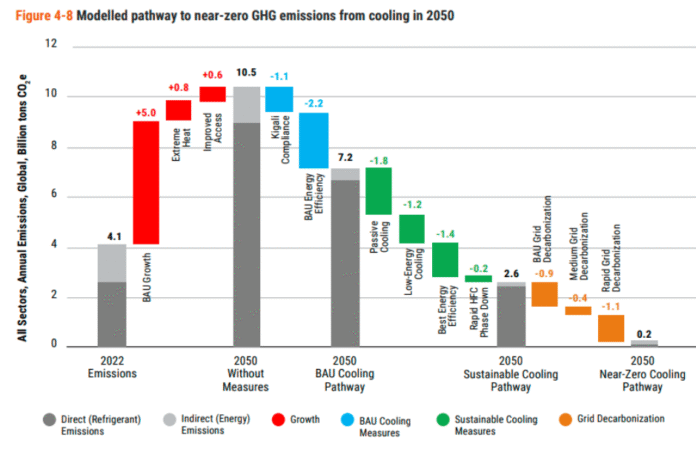The UN Environment Programme (UNEP) has released its Global Cooling Watch 2025 report at COP30 in Belem, Brazil, highlighting that global cooling demand could more than triple by 2050 unless countries shift toward sustainable, low-energy, and hybrid cooling systems. The report outlines a Sustainable Cooling Pathway that can drastically cut emissions, save trillions of dollars, and ensure equitable access to life-saving cooling. Here are ten key takeaways from the report:
1. Cooling Demand Set to Triple by 2050
Under a business-as-usual scenario, global cooling demand could increase more than threefold by 2050 due to rising heatwaves, urbanization, and growing incomes. Installed cooling capacity could rise from 22 terawatts in 2022 to 68 terawatts in 2050, driving up greenhouse gas emissions and energy demand.
2. Emissions Could Reach 7.2 Billion Tons of CO2e by 2050
Without intervention, cooling-related greenhouse gas emissions are projected to almost double compared to 2022 levels, reaching 7.2 billion tons of CO2 equivalent by 2050. This increase would strain power grids and undermine global climate goals.
3. Sustainable Cooling Pathway Offers 64 Percent Emission Cuts
The Sustainable Cooling Pathway proposed by UNEP could reduce projected emissions by 64 percent—equivalent to cutting 4.6 billion tons of CO2e by 2050. With the rapid decarbonization of the power sector, residual emissions could drop by as much as 97 percent below business-as-usual levels.
4. Trillions in Savings Through Energy and Infrastructure Efficiency
Implementing sustainable cooling could save up to 43 trillion US dollars in cumulative energy and infrastructure costs by 2050. Around 17 trillion dollars could be saved through energy efficiency, while 26 trillion dollars could be avoided in grid expansion investments.
5. Passive and Low-Energy Cooling Are Critical
Nearly two-thirds of potential emission reductions come from passive and low-energy solutions such as natural ventilation, reflective surfaces, shading, and urban greening. These strategies not only cut emissions but also make cooling more accessible and affordable for vulnerable communities.

6. Growing Policy Momentum, but Uneven Progress
Out of 192 countries analyzed, 134 have included cooling in their national climate strategies or energy plans. However, only 54 countries have comprehensive policies covering passive cooling, minimum energy performance standards, and refrigerant transitions—highlighting significant gaps in implementation.
7. Need for Stronger Building Energy Codes
While many nations have adopted energy performance standards, implementation gaps remain. For instance, 69 countries have residential building envelope standards, 58 have glazing standards, but only 19 require shading features —despite evidence that such measures can reduce indoor temperatures by 2.2°C and cut energy use by 29 percent.
8. Global Cooling Pledge Gains Momentum
Seventy-two nations have joined the Global Cooling Pledge to reduce cooling-related emissions by 68 percent by 2050. This commitment aligns with the Sustainable Cooling Pathway and reflects growing recognition of cooling as both a climate and development issue.
9. ‘Beat the Heat’ Initiative Driving Local Action
The Beat the Heat campaign, led by UNEP and Brazil’s COP30 presidency, is mobilizing cities and partners to implement sustainable cooling solutions. Over 185 cities—from Rio de Janeiro to Nairobi — have joined the initiative, alongside 83 partners working to localize the Global Cooling Pledge.
10. Call for Coordinated Global Action
UNEP urges countries to move from reactive to proactive governance on heat and cooling, treating access to cooling as a public good. The report emphasizes integrating passive design, nature-based solutions, and renewable-powered systems into national policies and urban planning to build heat-resilient, climate-smart cities.
The Global Cooling Watch 2025 report underscores that sustainable cooling is no longer optional — it is essential for protecting lives, stabilizing power systems, and achieving climate targets. By adopting the Sustainable Cooling Pathway, nations can deliver climate resilience while ensuring equitable access to safe, affordable cooling for billions of people worldwide.
Baburajan Kizhakedath

